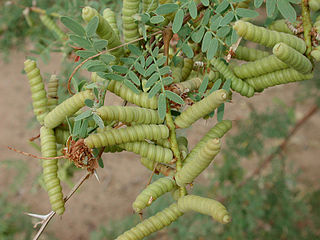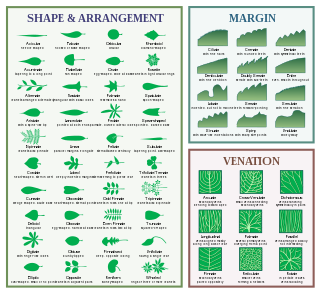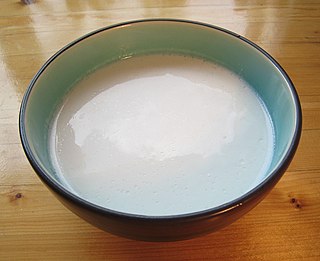
Syrah, also known as Shiraz, is a dark-skinned grape variety grown throughout the world and used primarily to produce red wine. In 1999, Syrah was found to be the offspring of two obscure grapes from southeastern France, Dureza and Mondeuse Blanche. Syrah should not be confused with Petite Sirah, a cross of Syrah with Peloursin dating from 1880.

Horticulture has been defined as the agriculture of plants, mainly for food, materials, comfort and beauty for decoration. According to American horticulturist Liberty Hyde Bailey, "Horticulture is the growing of flowers, fruits and vegetables, and of plants for ornament and fancy." A more precise definition can be given "The cultivation, processing, and sale of fruits, nuts, vegetables, and ornamental plants as well as many additional services". It also includes plant conservation, landscape restoration, soil management, landscape and garden design, construction and maintenance, and arboriculture. In contrast to agriculture, horticulture does not include large-scale crop production or animal husbandry.

An insectivore is a carnivorous plant or animal that eats insects. An alternative term is entomophage, which also refers to the human practice of eating insects.

Mesquite is a common name for several plants in the genus Prosopis, which contains over 40 species of small leguminous trees. They are native to the southwestern United States and Mexico. The mesquite originates in the Tamaulipan mezquital ecoregion, in the deserts and xeric shrublands biome, located in the southern United States and northeastern Mexico. It has extremely long roots to seek water from very far under ground. The region covers an area of 141,500 km2, encompassing a portion of the Gulf Coastal Plain in southern Texas, northern Tamaulipas, northeastern Coahuila, and part of Nuevo León. As a legume, mesquite is one of the few sources of fixed nitrogen in the desert habitat.

Plant reproductive morphology is the study of the physical form and structure of those parts of plants directly or indirectly concerned with sexual reproduction.

The following is a defined list of terms which are used to describe leaf morphology in the description and taxonomy of plants. Leaves may be simple or compound. The edge of the leaf may be regular or irregular, may be smooth or bearing hair, bristles or spines. For more terms describing other aspects of leaves besides their overall morphology see the leaf article.

Brassica nigra, or black mustard, is an annual plant cultivated for its black or dark brown seeds, which are commonly used as a spice. It is native to tropical regions of North Africa, temperate regions of Europe, and parts of Asia.

Kubota Corporation is a tractor and heavy equipment manufacturer based in Osaka, Japan. One of its notable contributions was to the construction of the Solar Ark. The company was established in 1890.
Photoperiodism is the physiological reaction of organisms to the length of night or a dark period. It occurs in plants and animals. Photoperiodism can also be defined as the developmental responses of plants to the relative lengths of light and dark periods. They are classified under three groups according to the photoperiods: short-day plants, long-day plants, and day-neutral plants.

The garden strawberry is a widely grown hybrid species of the genus Fragaria, collectively known as the strawberries, which are cultivated worldwide for their fruit. The fruit is widely appreciated for its characteristic aroma, bright red color, juicy texture, and sweetness. It is consumed in large quantities, either fresh or in such prepared foods as jam, juice, pies, ice cream, milkshakes, and chocolates. Artificial strawberry flavorings and aromas are also widely used in products such as candy, soap, lip gloss, perfume, and many others.

Plant milk refers to manufactured, nondairy beverages made from a water-based plant extract for flavouring and aroma. Plant milks are vegan beverages consumed as plant-based alternatives to dairy milk, and often provide a creamy mouthfeel. For commerce, plant-based liquids are typically packaged in containers similar and competitive to those used for animal lactations, but cannot be labeled as "milk" within the European Union. In 2018, among the roughly 20 plants used to manufacture plant milk, almond, soy, and coconut were the highest-selling plant milks worldwide. The global plant milk market was estimated at US$16 billion in 2018.

American LaFrance (ALF) was an American vehicle manufacturer which focused primarily on the production of fire engines, fire aerials, and emergency apparatus such as ambulance and rescue vehicles. The company was located in Summerville, South Carolina. It was announced Friday, January 17, 2014, they would cease operations.

Phytolacca americana, also known as American pokeweed, pokeweed, poke sallet, or poke salad, is a poisonous, herbaceous perennial plant in the pokeweed family Phytolaccaceae growing up to 8 ft (2.4m) in height. It has simple leaves on green to red or purplish stems and a large white taproot. The flowers are green to white, followed by purple to almost black berries which are a food source for songbirds such as gray catbird, northern mockingbird, northern cardinal, and brown thrasher, as well as other birds and some small animals.

Apigenin (4′,5,7-trihydroxyflavone), found in many plants, is a natural product belonging to the flavone class that is the aglycone of several naturally occurring glycosides. It is a yellow crystalline solid that has been used to dye wool.

Kaempferol (3,4′,5,7-tetrahydroxyflavone) is a natural flavonol, a type of flavonoid, found in a variety of plants and plant-derived foods including kale, beans, tea, spinach and broccoli. Kaempferol is a yellow crystalline solid with a melting point of 276–278 °C (529–532 °F). It is slightly soluble in water and highly soluble in hot ethanol, ethers, and DMSO. Kaempferol is named for 17th-century German naturalist Engelbert Kaempfer.
Benyvirus is a genus of viruses, in the family Benyviridae. Plant serve as natural hosts. There are currently four species in this genus including the type species Beet necrotic yellow vein virus. Diseases associated with this genus include: BNYVV: rhizomania.

The Timber Culture Act was a follow-up act to the Homestead Act. The Timber Culture Act was passed by Congress in 1873. The act allowed homesteaders to get another 160 acres (65 ha) of land if they planted trees on one-fourth of the land, because the land was "almost one entire plain of grass, which is and ever must be useless to cultivating man."

Semmozhi Poonga is a botanical garden in Chennai set up jointly by the Horticulture and Agricultural Engineering department of the Government of Tamil Nadu. The garden was opened on 24 November 2010 by then chief Minister Dr.M. Karunanidhi and is the first botanical garden in the city. The garden is located in the Cathedral Road–Anna Salai junction, opposite the American Consulate, on the erstwhile Drive-in Woodlands Hotel. Encompassing an area of 20 acres, it was built at a cost of ₹ 80 million. More than 500 species of plants are being grown in the area, in addition to the 80 trees that was already in existence during the development of the park, some of them being more than 100 years old. The garden houses some of the popular exotic flora and rare plant species, medicinal and aromatic herbs. Many of the exotic plants are imported from countries like China and Thailand, including a plethora of bonsai varieties of ficus microcarpa and ficus ginseng.

The Basic Leucine Zipper Domain is found in many DNA binding eukaryotic proteins. One part of the domain contains a region that mediates sequence specific DNA binding properties and the leucine zipper that is required to hold together (dimerize) two DNA binding regions. The DNA binding region comprises a number of basic amino acids such as arginine and lysine. Proteins containing this domain are transcription factors.

Iris mariae is a species in the genus Iris, it is also in the subgenus of Iris and in the Oncocyclus section. t is a rhizomatous perennial, from the deserts of Israel and Egypt. It is fairly tall, with long and slender glaucous leaves, and in late spring, lilac-purple to pinkish or violet flowers with deeper veining and blackish-violet signal and dark purple beard.


















